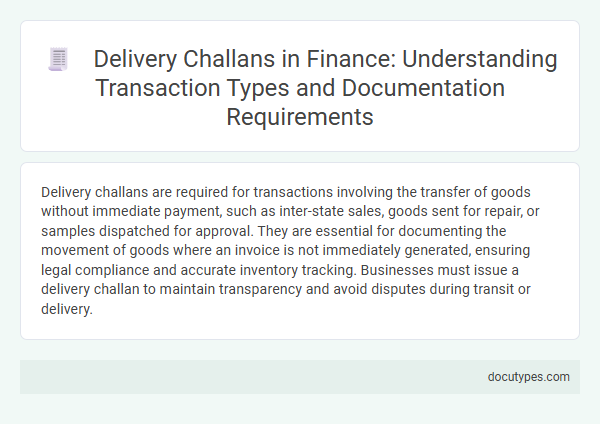Delivery challans are required for transactions involving the transfer of goods without immediate payment, such as inter-state sales, goods sent for repair, or samples dispatched for approval. They are essential for documenting the movement of goods where an invoice is not immediately generated, ensuring legal compliance and accurate inventory tracking. Businesses must issue a delivery challan to maintain transparency and avoid disputes during transit or delivery.
Introduction to Delivery Challans in Finance
In finance, a delivery challan serves as a crucial document for tracking the transfer of goods without immediate payment. It ensures transparency and accountability during the movement of products between parties.
- Goods Transfer Between Branches - A delivery challan documents the internal transfer of inventory between different branches of the same company.
- Consignment Stock Dispatch - It records the dispatch of goods sent on consignment to dealers or agents without a sales invoice.
- Transportation of Goods for Job Work - A delivery challan accompanies materials sent to a subcontractor or job worker for processing or manufacturing.
Definition and Purpose of Delivery Challans
A delivery challan is a document issued by a seller to the buyer as a proof of goods being dispatched or delivered without an immediate invoice. It serves to track the transfer of goods during shipments, ensuring transparency and accountability between parties.
Transactions that involve the movement of goods without an instant sale or payment, such as inter-branch transfers, job work consignments, or stock shipments for repairs, require a delivery challan. This document helps maintain accurate records in these non-invoiced transactions, preventing discrepancies in inventory and taxation compliance.
Key Elements of a Delivery Challan
Types of transactions requiring a delivery challan include goods transfers between branches, supply of goods without immediate sale, and replacement of goods under warranty. Key elements of a delivery challan comprise the description of goods, quantity, delivery date, and sender and receiver details. You must ensure these details are accurately recorded to maintain proper documentation and compliance in financial transactions.
Types of Transactions Requiring Delivery Challans
Delivery challans are required for transactions involving the movement of goods without immediate payment or invoice generation. Common types include goods sent for job work, goods dispatched on approval, and stock transfers between different branches. You must ensure a delivery challan accompanies these transactions to maintain accurate records and comply with regulatory requirements.
Legal and Regulatory Framework for Delivery Challans
What types of transactions require a delivery challan under the legal and regulatory framework? Delivery challans are mandatory for the movement of goods without an immediate sale, such as consignments, transfer of goods between branches, and shipment of goods for job work. Your compliance with these requirements ensures proper documentation as per tax laws and helps avoid penalties during audits.
Documentation Requirements for Delivery Challans
Delivery challans are essential for transactions involving the transportation of goods without immediate payment, such as stock transfers between branches or sending goods for job work. These documents act as proof of delivery and facilitate proper tracking within the supply chain.
Accurate documentation on delivery challans must include details like the description of goods, quantity, date of dispatch, and recipient information. Maintaining these records ensures compliance with tax regulations and smooth reconciliation during audits or returns.
Differences Between Delivery Challans and Tax Invoices
Delivery challans are essential documents used in specific types of financial transactions to track the movement of goods without the immediate transfer of ownership. Understanding the differences between delivery challans and tax invoices helps ensure compliance with regulatory requirements and accurate record-keeping.
- Transactions Requiring Delivery Challans - Delivery challans are typically required during the transportation of goods for job work, stock transfers between branches, and goods sent on approval or returnable basis.
- Purpose of Delivery Challans - They serve as proof of delivery and ensure accountability but do not serve as a demand for payment or tax collection.
- Differences from Tax Invoices - Unlike tax invoices, delivery challans do not include tax amounts and are not used for input tax credit claims, highlighting their distinct role in financial documentation.
Electronic vs. Physical Delivery Challans
Delivery challans are essential documents used to track the movement of goods during various types of transactions. Understanding when to use electronic or physical delivery challans helps streamline financial and logistical processes.
- Electronic Delivery Challans - Used primarily for digital record-keeping and transactions involving e-commerce or inter-branch transfers within your organization.
- Physical Delivery Challans - Required for tangible goods transported between locations without immediate payment or tax invoice issuance.
- Transactions Requiring Delivery Challans - Includes goods sent on approval, job work consignments, and stock transfers which must be documented for legal and audit purposes.
Choosing the correct type of delivery challan ensures compliance with financial regulations and enhances your transaction transparency.
Common Challenges and Best Practices in Managing Delivery Challans
| Types of Transactions Requiring a Delivery Challan | Common Challenges in Managing Delivery Challans | Best Practices for Efficient Delivery Challan Management |
|---|---|---|
|
|
|
What Types of Transactions Require a Delivery Challan? Infographic

